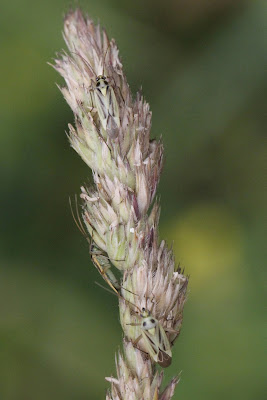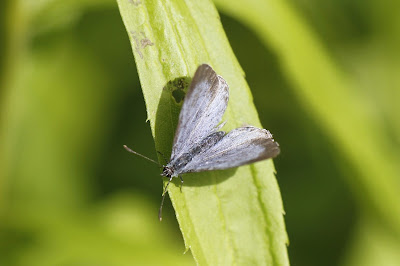A very windy visit to the slope below Biggin Hill Airport produced my first Chalkhill Blue of the
year , a freshly emerged male , hanging on for dear life on an umbellifer . The few other butterflies
around , like this Large White , were also making themselves as small as possible to resist being blown off their perch . The visit also produced a close up of the day flying moth Oncocera
semirubella that seemed pleased to get some warmth from my finger , but sadly no sign of either Clouded Yellow or Dark Green Fritillary , both seen on site last year . On the way home , I stopped off for a look at Salt Box Hill , a SSSI managed by London Wildlife Trust , having heard that the ponies and goats had been removed . The latter proved true , but only to the other fenced off area to the left of the steps down , and the probable cause was the SSSI being treated with chemicals ( ragging ) to control the scrub which is once again invading the area . To my knowledge , this will be the 5th. attempt to get the area to it's SSSI citation of being a 'chalk grassland ' , as at the moment it resembles no more than a field , mostly covered in scrub and weeds . Butterflies were at a premium , with just 10/15 Marbled White ( I have recorded 250+ on site in the past before grazing was introduced ) and a few Meadow Brown and Gatekeeper being recorded . The highlight for me was
another White Pyramidal Orchid , the third specimen I have seen and photographed this year , having never seeing one previously . Much more common were Bittersweet , Common Cleavers , Weld
( pictured ) and Plantains , all species of waste and scrubby areas , along with plenty of regenerating trees and scrub which seemed to have missed the ' rag ' .
Another windy visit was to New Hythe , the patch of Phil / Sharp by Nature . I hadn't visited since the Spring , when the scar and loss of habitat caused by a new pipeline being layed across the site was a real shock . Although the pipeline has been completed and ' remedial work ' done , unfortunately the habitat , especially that which was favoured by several Nightingale pairs will take years to recover , if ever . Whilst searching for Odonata on Abbeymead lake , my phone rang and it was Phil , who had seen my car in the car park . We met up and spent the rest of the morning catching up and having a good look around . The river was down , but a fly-by Kingfisher and an Oystercatcher were the only highlights from the ' bucket seat ' . As we passed between Brooklands and Abbeymead , Phill picked up Tern calls but we couldn't get a clear view , but later what appeared to be a family group showed
up again and a juvenile Common Tern made it into the viewfinder . The wind didn't help with the Odonata , but several Brown and Southern Hawker were seen , but most numerous species of
dragonfly was the Emperor , mostly in flight , but also a couple of ovipositing females . As we passed
the end of the Railway lake , Phil spotted this female Brown Hawker , busily ovipositing , before bing chased off by Black-tailed Skimmers . No sign of Water Vole in their favoured ditch , and returning to the car park along the Millstream , we searched for Sm. Red-eyed Damselfly , but once again the wind didn't do us any favours to be sure of their ID , with their larger relations occupying the same areas . Just before reaching the car park , a first of the year for me , the 'purring' of a Turtle Dove , which I also managed to get a brief glimpse as it flew off . We went our separate ways from the car park , me to White Hill above Shoreham , the Kent BC site managed specifically for the Chalkhill Blue , which I heard were on the wing from fellow enthusiast Keith . Once again , the wind made things difficult , along with the 12 or so males constantly charging around searching for females .
Fortunately , the odd cloud passed over , enabling a few shots of the males at rest . No sign of any females having emerged yet on site .
On the way home , a stop near Lullingstone found the Green-flowered Helleborines in flower bud , but yet to open . Interestingly , this species has the ability to self-fertilise , sometimes in the unopened flower .
As mentioned in the previous post , the White-letter Hairstreaks posed superbly for the Kent BC members last Sunday , but I didn't have a camera with me , so during the week I returned for a short visit and to get some shots . Four specimens came down to nectar on the Canadian Golden Rod , three
were males showing wear and damage from the aerial battles I had seen at the top on the Ash tree for the previous three weeks , but the fourth was a pristine female , larger in size and with longer tails on
the hindwing . Whilst waiting for the WLH to come down , good numbers of 6-spot Burnet moths ,
and on the CGRod , a small moth which I believe is a Small Purple Bar .
The other interest seen was this very light coloured female Large Skipper , a species coming towards
the end of it's flight period .
On Thursday I did the High Elms transect which produced the best return of the year so far , of 21 species . Having said that , some species were again in low numbers , like just 2 Speckled Wood ( best count has only reached 5 ) , Small Heath - 1 ( the only record this season ) , Holly Blue-1 ( only
the second record ) , Brown Argus-1- pictured ( only the third record ) . Doing better , but still fewer than in previous years , the Silver-washed Fritillary-19 , but 8 of those recorded were females ( lower
picture ) , so hopefully that bodes well for next year , fingers crossed .
Yesterday I helped with the Down House transect , which like High Elms wasn't outstanding , but we did record 15/20 Small Copper , a species I have failed to record at HE at all this year , and two first for the year for the transect , Brown Argus and Silver-washed Fritillary .
And finally , a couple of the more unusual shots I managed to get of the Purple Emperors a week ago
at High Elms . Pure luck to photographing them on the ground , only for them to take flight , and in


































































